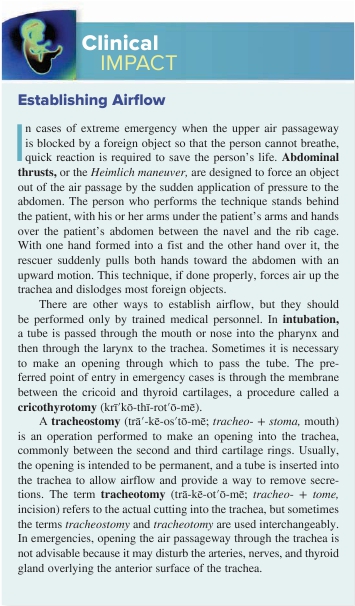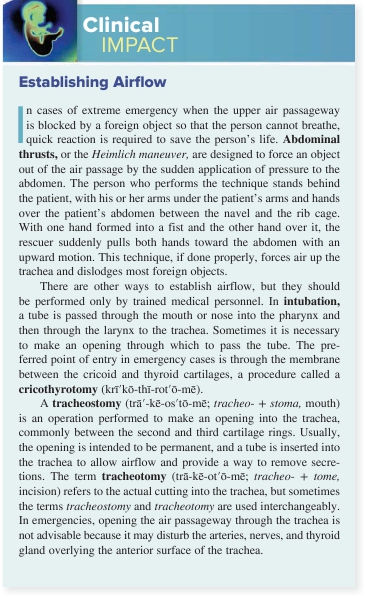828


PART 4 Regulation and Maintenance
folds, places them in position for producing sounds, and changesthe tension on them (figure 23.4
d
). Anterior movement of thearytenoid cartilages decreases the length and tension of thevocal folds, lowering pitch. Posterior movement of the arytenoidcartilages increases the length and tension of the vocal folds,increasing pitch (figure 23.4
e
).4. The pseudostratified ciliated columnar epithelium lining thelarynx produces mucus, which traps debris in air. The ciliamove the mucus and debris into the pharynx.
Predict 2
Jake told his girlfriend that the rollercoaster did not bother him, butduring the ride he let loose with a long, high-pitched scream. Explainhow the muscles of respiration, the muscles that control the vocal folds,and the muscles that move the epiglottis produced Jake’s scream.

ASSESS
YOUR PROGRESS
8.
Name and describe the three single cartilages of thelarynx. What are their functions?
9.
Distinguish between the vestibular and vocal folds. How aresounds of different loudness and pitch produced by thevocal folds?
10.
How does the position of the arytenoid cartilages changewhen a person is simply breathing versus making low-pitched and high-pitched sounds?
11.
What are the four functions of the larynx?
Trachea
The
trachea
(tr ā ′k ē - ă ), or windpipe, allows air to flow into thelungs. It is a membranous tube attached to the larynx. It consists ofdense regular connective tissue and smooth muscle (see figure 23.2).Reinforcing the trachea are 15–20 C-shaped pieces of hyalinecartilage. The cartilages support the anterior and lateral sides of thetrachea to protect the trachea and maintain an open passageway forair (figure 23.5
a
). Because the tracheal rings do not completely sur-round the entire trachea, the posterior wall of the trachea is devoid ofcartilage. Instead, it contains an elastic ligamentous membraneand bundles of smooth muscle called the
trachealis
(tr ā ′k ē - ā -lis)
muscle.
Contraction of this smooth muscle can narrow the diameterof the trachea, which aids in coughing. Narrowing the trachea’sdiameter causes air to move more forcefully through the trachea,helping to expel mucus and foreign objects during coughing. Theesophagus lies immediately posterior to the cartilage-free poste-rior wall of the trachea.
Predict 3
Explain what happens to the shape of the trachea when a person swallowsa large mouthful of food. Why is this change of shape advantageous?
A mucous membrane lines the trachea (figure 23.5
b
). Themembrane’s goblet cells produce mucus, which traps inhaleddust, bacteria, and other foreign matter. The ciliated epitheliumthen moves the mucus and foreign matter into the larynx. Fromthe larynx the foreign matter enters the pharynx and is swallowed
(figure 23.5
b,c
). Constant, long-term irritation to the trachea, asoccurs in smokers, can cause the tracheal epithelium to becomemoist stratified squamous epithelium that lacks cilia and gobletcells. This transition prevents the normal function of the trachealepithelium.The trachea has an inside diameter of 12 mm and a length of10–12 cm, descending from the larynx to the level of the fifth thoracicvertebra (figure 23.6). The trachea divides to form two smallertubes called
main bronchi,
or
primary bronchi
(brong′k ī ; sing.bronchus, brong′k ŭ s; windpipe), each of which extends to a lung.The tracheal cartilage separating the openings into the main bron-chi forms a ridge called the
carina
(k ă -r ī ′n ă ). The carina is animportant landmark for reading x-rays. In addition, the mucousmembrane of the carina is very sensitive to mechanical stimulation.If foreign matter is inhaled to the level of the carina, it stimulates apowerful cough reflex. Materials in the air passageways beyondthe carina do not usually stimulate a cough reflex.